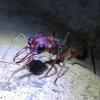Hi Serafine. Thanks for taking interest in my question. Just to clarify, my question was really just about the contiguous United States. I agree with you that if we take all species across the world into account, then the answer would be pretty useless, just like you said.
Just so that we're both on that same page, the per-species temperature that I keep referring to is a species' max comfort temperature. In other words, suppose I take some ants of that species and throw them into a container with plenty of drinking water. Then, suppose I start slowly heating one side of the container. At what temperature will the ants begin to avoid the heated area? I just wanted to be sure we're talking about the same measurement.
Like you, I too would really love to have a "species table" with this information, which is really why I suggested in my question that we just try to just imagine the list. I say "imagine" because we're just not realistically going to find one  , which is why I'm relying on seasoned ant keepers like yourself to share what you've learned from experience. Having visited Germany once, the weather seems similar to that of Pennsylvania USA, which is where I live. Meaning, you have some very valuable experience! So, thanks for your ongoing participation on this topic!
, which is why I'm relying on seasoned ant keepers like yourself to share what you've learned from experience. Having visited Germany once, the weather seems similar to that of Pennsylvania USA, which is where I live. Meaning, you have some very valuable experience! So, thanks for your ongoing participation on this topic! 
















